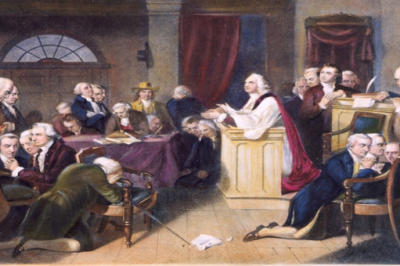The anarchists in Portland, Oregon, who pulled down the statue of George Washington and burned an American flag also spray-painted “1619” on the fallen statue. “1619” is the new historical paradigm propagated by those on the Left who see America as a racist, evil nation in need of a complete socialist makeover.
This historical perspective was launched by The New York Times in its”1619 Project.” The stated goal of this project is to “reframe” American history by insisting that 1619, when the first African slaves were brought to this land, marks America’s true founding, not 1776.
Those who see America through the lens of 1619 see a nation that is evil and racist at its very core and in need of radical transformation.
The ‘1726 Project’
During the summer of 2019, before I heard of the “1619 Project,” I experienced a deep stirring in my spirit to write the book 1726 with the subtitle, The Year that Defined America.
In 1726, a Great Awakening began that spiritually and morally transformed colonial America. This awakening also unleashed a powerful anti-slavery movement that turned America’s founders against slavery. It was truly a defining year for America.
Benjamin Franklin told how the awakening transformed his hometown of Philadelphia in 1739. He wrote, “From being thoughtless or indifferent about religion, it seemed as if all the world were growing religious so that one could not walk through the town in an evening without hearing psalms sung in different families of every street.
That blacks and whites worshipped together in this awakening is made clear by George Whitefield’s account of the same revival. After preaching his farewell sermon to a massive crowd gathered in front of the Philadelphia courthouse, Whitefield noted in his Journal, “Near 50 Negroes came to give me thanks for what God had done for their souls.” Whitefield considered this an answer to prayer, saying, “I have been much drawn in prayer for them, and have seen them wrought upon by the word preached” (Hyatt, 1726: The Year That Defined America, 70).
Revival and Abolition
Out of this awakening, racial and cultural barriers were breached. Because of this awakening, anti-slavery sentiments blossomed, and an abolition movement burst forth with awakening preachers proclaiming slavery to be morally wrong and sinful.
To cite just one example; Samuel Hopkins (1721–1803), who had been personally tutored by Jonathan Edwards, pastored for a time in Newport, Rhode Island, an important hub in the transatlantic slave trade. Like Paul, whose spirit was “provoked” by the idols he saw in Athens, Hopkins was grieved and incensed by the “violation of God’s will” he saw in Newport. He declared, “This whole country have their hands full of blood this day” (Hyatt, 1726: The Year that DefinedAmerica, 92).
He began to passionately preach against slavery and in 1774, after the First Continental Congress had convened in Philadelphia, Hopkins sent a pamphlet to every member of the Congress, asking how they could complain about “enslavement” to England and overlook the “enslavement” of so many blacks in the colonies.
At a time when slavery was accepted and practiced in most of the world, there was a powerful movement in America against it. The brilliant black scholar, Dr. Thomas Sowell, has noted this, saying,
“Slavery was just not an issue, not even among intellectuals, much less among political leaders, until the 18th century—and then it was an issue only in Western civilization. Among those who turned against slavery in the 18th century were George Washington, Thomas Jefferson, Patrick Henry, and other American leaders. You could research all of 18th-century Africa or Asia or the Middle East without finding any comparable rejection of slavery there” (Hyatt, 1726: The Year That DefinedAmerica, 90).
Yes, slavery was practiced for thousands of years in Africa, Asia, the Middle East and other parts of the world before it was brought to this continent. When compared with world history, the unique characteristics of slavery in America were the brevity of its existence and the moral outrage against it. This can only be explained by 1726 and the Great Awakening that began that year. Indeed, 1726 defined and redefined America.
1726 Impacts America’s Founders
The spiritual power of the awakening and the moral arguments it produced against slavery were overwhelming. In fact, by the time of the writing of the Declaration of Independence in 1776 and the Constitution in 1787, virtually every founder had taken a public stand against slavery. Virtually all agreed with John Adams, who stated the following:
“Every measure of prudence ought to be assumed for the eventual total extirpation of slavery from the United States. I have throughout my whole life held the practice of slavery in abhorrence” (Hyatt, 1726: The Year that Defined America, 101).
Two years before the Constitutional Convention, Benjamin Franklin freed his two slaves and began to advocate for abolition. He joined the Abolition of Society of Philadelphia and later served as its president.
Benjamin Rush, a Philadelphia physician and signer of the Declaration of Independence, helped found the first Abolition Society in America in his hometown of Philadelphia. He called on the ministers of America to take a public stand against slavery, saying, “Slavery is a Hydra sin and includes in it every violation of the precepts of the Laws and the Gospels” (Hyatt, 1726: The Year That Defined America, 100-01)).
Confronted with the inconsistency of a Christian testimony and owning slaves, George Washington set in motion a compassionate program to completely rid Mt. Vernon of slavery. Those slaves who wanted to leave were free to do so, and those who chose to stay were paid wages. He also set in motion an educational program to prepare the children of slaves for freedom. Concerning the abolition of slavery, Washington wrote:
“Not only do I pray for it, on the score of human dignity, but I can clearly foresee that nothing but the rooting out of slavery can perpetuate the existence of our union by consolidating it in a common bond of principle” (Hyatt, 1726: The Year That Defined America, 103).
In the words of Dr. Sowell, “You could research all of 18th-century Africa or Asia or the Middle East without finding any comparable rejection of slavery there.” This moral rejection of slavery was the fruit of 1726.
Deciding that slavery was wrong, however, was easier than deciding what to do with 2 million people from another continent and culture who were unprepared for freedom. Dr. Sowell has said,
“It is clear from the private correspondence of Washington, Jefferson and many others that their moral rejection of slavery was unambiguous, but the practical question of what to do now had them baffled. That would remain so for more than half a century.”
1726 Was America’s Key for Ending Slavery
The cancerous tentacles of slavery had become so entangled with Southern economics and culture that it was obvious it would take drastic and painful measures to excise it from the nation. America would require a rare moral resolve to endure the painful surgery that would be required.
America found that moral resolve in the spiritual awakenings that had come to define her, beginning in 1726. As a result of 1726, spiritual awakening seemed to be imprinted in her national DNA, and succeeding generations turned to God in times of distress.
As a result, a Second Great Awakening (1800-30) erupted and out of it a new movement of abolition. Then, the Great Prayer Awakening (1857-58) gripped the nation and provided the final spiritual and moral resolve necessary to carry the nation through a bloody Civil War and the final abolition of slavery.
Yes, it took great moral resolve to sacrifice one million of her citizens to end slavery. This number includes 700,000 soldiers who died plus civilian casualties and the thousands who were maimed and injured. America’s population at the time was only 31 million.
If the numbers are adjusted to correspond with today’s population, it would be like sacrificing 10 million citizens for a contemporary moral cause. We see the magnitude of the sacrifice when we remember that less than 3,000 Americans died at 9/11.
A nation that would make such a sacrifice to end slavery, cannot be racist. Yes, there are racists in America, but the nation has proven itself to be anti-racist. For this we can thank God and 1726.
Will We Choose 1619 or 1726?
Those who see America through the lens of 1619 deny the providential hand of God in America’s birth and history. They dismiss 1726 as a mere human outburst of religious fervor and fanaticism. They see only human shortcoming and sin in America’s history, which they now purport to correct.
In contrast, those who see America through the lens of 1726 see the providential hand of God in her origins, as did her founders. They acknowledge her sins and failures but also acknowledge her noble triumphs and achievements.
Those who see America through the lens of 1726 believe that God has a divine purpose for this land, that is yet to be completed. Dr. Martin Luther King Jr. expressed this in his 1968 “I Have a Dream” speech when he declared, “I have a dream. It is a dream deeply rooted in the American dream.”
President Ronald Reagan expressed this in his 1982 Thanksgiving Proclamation. He said,
“I have always believed that this anointed land was set apart in an uncommon way, that a divine plan placed this great continent here between the oceans to be found by people from every corner of the earth who had a special love of faith and freedom.”
Recovering this 1726 paradigm of America’s history is critical, for as George Orwell said in his classic book, 1984, “Whoever controls the past, controls the future.” And commenting on the demise of nations in world history, Carl Sandburg, winner of two Pulitzer Prizes, said, “When a nation goes down, or a society perishes, one condition may always be found: They forgot where they came from. They lost sight of what had brought them along.”
Recovering the knowledge of 1726 is paramount in getting it right about our nation. Only another 1726 will save America, heal her wounds and preserve her liberty for the next generation.
Let us, therefore, remember 1726 and pray, “Lord, do it again!” {eoa}
This article is derived from Dr. Eddie Hyatt’s latest book, 1726: The Year that Defined America, available from Amazon and his website at eddiehyatt.com. He is also the founder of the “1726 Project” that is dedicated to educating America about her roots in spiritual awakening and calling American Christians to pray for another national, spiritual awakening.
For the original article, visit biblicalawakening.blogspot.com.







Leave a Comment
You must be logged in to post a comment.